Askey Computer TC7300 Cable Modem User Manual TC7300 d1TI rev
Askey Computer Corp Cable Modem TC7300 d1TI rev
Contents
- 1. User Manual (TC7300.d1TI) rev.pdf
- 2. User Manual (TC7300.TI) rev.pdf
User Manual (TC7300.d1TI) rev.pdf
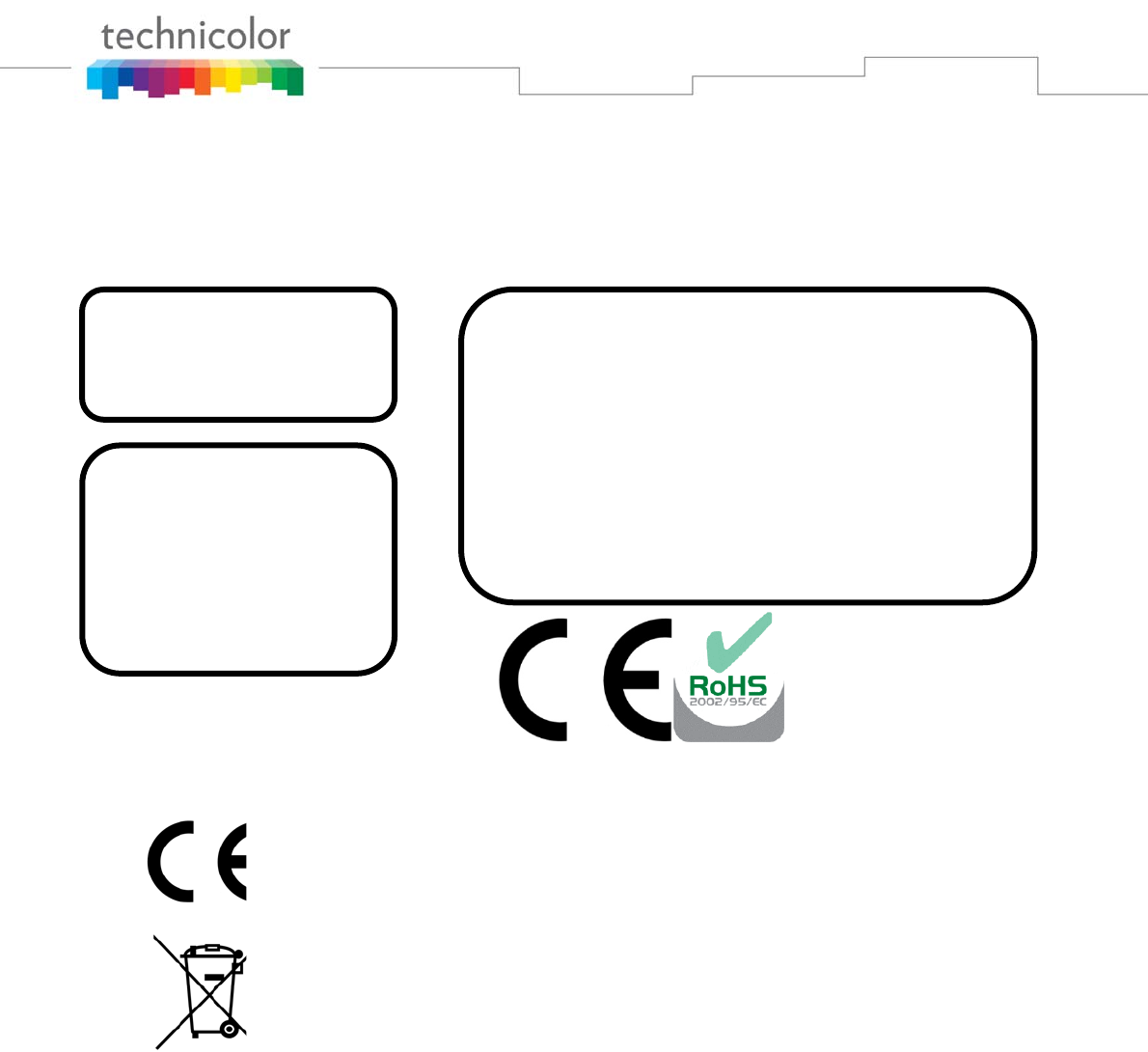
Page1/25
Cable Modem
TC7300.d1TI
This symbol on the product ensures that the device complies with European legislation, Directive 89/336/EEC,
73/23/EEC, 93/68/EEC, which covers the EMC (electromagnetic compatibility), and safety aspects of marking.
This symbol means that your inoperative electronic appliance must be collected separately and not mixed with the
household waste. The European Union has implemented a specific collection and recycling system for which
producers' are responsible.
This appliance has been designed and manufactured with high quality materials and components that can be recycled
and reused. Electrical and electronic appliances are liable to contain parts that are necessary in order for the system to
work properly but which can become a health and environmental hazard if they are not handled or disposed of in the
proper way. Consequently, please do not throw out your inoperative appliance with the household waste.
If you are the owner of the appliance, you must deposit it at the appropriate local collection point or leave it with the
vendor when buying a new appliance.
- If you are a professional user, please follow your supplier's instructions.
- If the appliance is rented to you or left in your care, please contact your service provider.
Help us protect the environment in which we live!
CAUTION
Disconnect power before
servicing.
This device is intended for
indoor operation only.
Telephone jacks Line 1 and
Line 2 must not be connected
to outside wiring.
CAUTION
To ensure reliable operation and to prevent overheating,
provide adequate ventilation for this modem and keep it
away from heat sources. Do not locate near heat registers
or other heat-producing equipment. Provide for free air
flow around the Wireless Voice Gateway and its power
supply.

Page2/25
NORTH AMERICAN CABLE INSTALLER:
This reminder is provided to call your attention to Article 820-40 of the National Electrical Code (Section 54
of the Canadian Electrical Code, Part 1) which provides guidelines for proper grounding and, in particular,
specifies that the cable ground shall be connected to the grounding system of the building as close to the
point of cable entry as practical.
Operating Information
Operating Temperature: 0˚ - 40˚ C (32˚ - 104˚ F)
Storage Temperature: -20˚ to 70˚ C (-4˚ – 157˚ F)
If you purchased this product at a retail outlet, please read the following:
Product Information
Keep your sales receipt to obtain warranty parts and service and for proof of purchase. Attach it here and
record the serial and model numbers in case you need them. The numbers are located on the back of the
product.
Model No. ____________________________Serial No ________________________________
Purchase Date: ________________________Dealer/Address/Phone: _________________________

Page3/25
Safety Recommendations
REMEMBER SAFETY FIRST
Using equipment safely
Your Cable Modem has been manufactured to meet safety standards, but you must take care if you want it to
perform properly and safely.
It is important that you read this booklet completely, especially the safety instructions below. If you have
any doubts about the installation, operation or safety of decoder, please contact your supplier.
To avoid the risk of electric shock
• Disconnect the Cable Modem from the mains supply before you connect the Cable Modem to (or
disconnect it from) any other equipment. Remember that contact with 110 Volt AC mains can be lethal
or cause severe electric shock.
• Never remove the Cable Modem’s cover. Should the Cable Modem fail, contact the Customer Service to
arrange repair or service.
• Never allow anyone to push anything into holes, slots or any other opening in the case
• Do not block the Cable Modem’s ventilation slots; never stand it on soft furnishings or carpets
• Do not put anything on the Cable Modem which might spill or drip into it (eg. Lighted candles or
containers of liquids). Do not expose the Cable Modem to dripping or splashing. If an object or liquid
enters inside the Cable Modem, unplug it immediately and contact the Customer Service.
• Do not store the Cable Modem in excessively hot, cold or damp conditions. The Cable Modem is
intended to operate at an ambient temperature of less than 40 degrees Celsius and a maximum humidity
level of 75%. In case of a storm, it is recommended that you unplug the Cable Modem from the mains
and from the TV set.
• Leave the mains socket accessible so that you can unplug the set quickly
Connecting to the mains supply
• This Cable Modem is designed to operate at 110 ~ 240 VAC.
• If you are in any doubt about the mains lead, the plug or connection, please consult the Customer Service.
• Only the power adapter supplied with the decoder has to be used
Ensuring optimum performance
• Leave 7cm to 10cm around the Cable Modem to ensure that proper ventilation gets to the Cable Modem.
• Do not store your Cable Modem on its side (if not allowed)
• To clean the Cable Modem, use a dry, clean soft cloth with no cleaning solvent or abrasive products.
Clean the ventilation openings regularly.

Page4/25
MAIN TECHNICALSPECIFICATIONS
General
Operating voltage 110 ~ 240 VAC
Typical Power consumption 18W max
Dimensions (W x H x D) 220mm x 166.7mm x 43mm
Operating temperature range 0 – 40 °C
Storage temperature range -20 – 70 °C
AC adapter (or plug-in
adapter) type ADAPTER 18W 12VDC/1.5A
Connections
DC input 12V/ 1.5A
Cable input 1xCoaxial cable connector
Phone plugs 2xRJ11
Ethernet plugs 4xRJ-45
This symbol on your set guarantees that your product complies with the European Directives 1999/5/ECand
2009/125/EC on Safety, Telecom, Electromagnetic Compatibility and Energy related Products.

Page5/25
Chapter 1: Connections and Setup .............................................................................................. 6
Turning on the Wireless Gateway .............................................................................................. 6
Introduction ............................................................................................................................. 6
Wireless Gateway Features ..................................................................................................... 6
What’s on the CD-ROM ......................................................................................................... 7
Computer Requirements ........................................................................................................ 7
Wireless Gateway Overview ....................................................................................................... 8
Front Panel ............................................................................................................................ 8
Rear Panel ........................................................................................................................... 10
Side Panel for WPS .................................................................................................................. 10
Wall Mounting ..................................................................................................................... 11
Relationship among the Devices ............................................................................................. 12
What the Modem Does ........................................................................................................ 12
What the Modem Needs to Do Its Job ................................................................................... 12
Contact Your Local Cable Company ..................................................................................... 12
Connecting the Wireless Gateway to a Single Computer .......................................................... 13
Attaching the Cable TV Wire to the Wireless Gateway ........................................................... 14
Installation procedure for connecting to the Ethernet interface ............................................ 15
Connecting More Than one Computer to the Wireless Gateway ............................................ 16
Chapter 2: WEB Configuration ................................................................................................... 17
Accessing the Web Configuration ........................................................................................... 17
Outline of Web Manager ...................................................................................................... 17
Gateway – Status Web Page Group .......................................................................................... 19
Software ...................................................................................................................... ........ 19
Connection .......................................................................................................................... 20
Chapter 3: Additional Information............................................................................................. 21
Frequently Asked Questions ................................................................................................... 21
General Troubleshooting ........................................................................................................ 22
Service Information ................................................................................................................ 23
Glossary ................................................................................................................................. 24
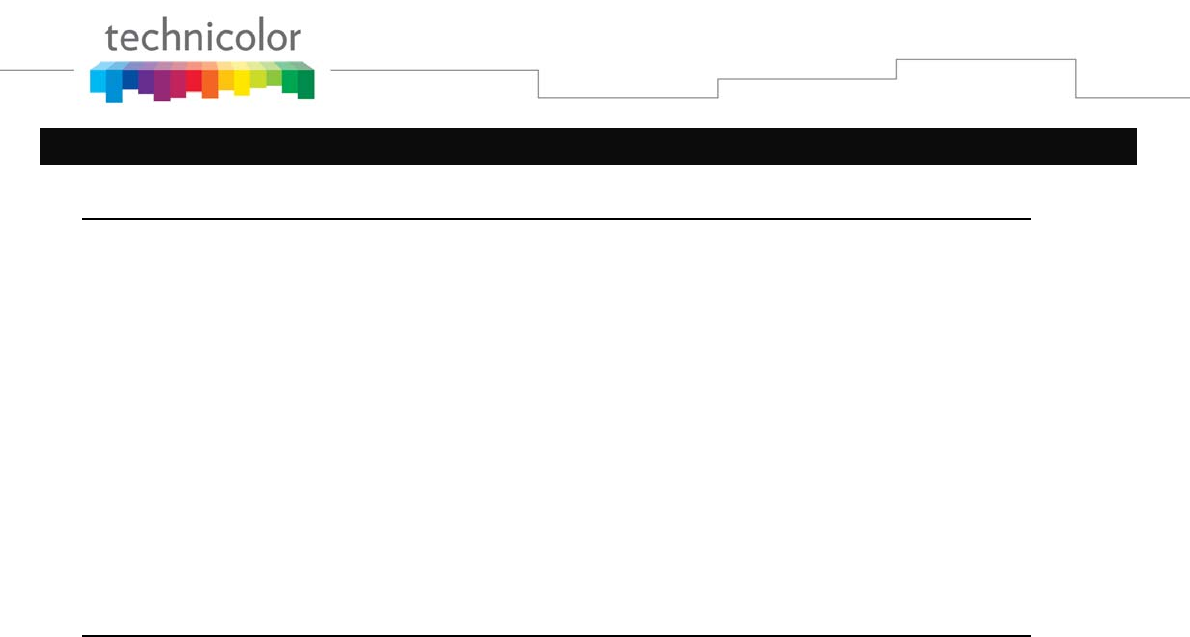
Page6/25
CHAPTER 1: CONNECTIONS AND SETUP
Turning on the Wireless Gateway
If there is no lighted LEDs on the front panel, check the power adapter plug-in the power jack and connect to
CM correctly.
After installing the Wireless Gateway and turn it on for the first time (and each time the modem is
reconnected to the power), it goes through several steps before it can be used. Each of these steps is
represented by a different pattern of flashing lights on the front of the modem.
Note: All indicators flash once before the initialization sequence.
If both DS and US LEDs are flashing, it means the Wireless Gateway is automatically updating its system
software. Please wait for the lights to stop flashing. Do not remove the power supply or reset the Wireless e
Gateway during this process.
Introduction
Wireless Gateway Features
z FullBandCaptureFrontEnd
z Increasesperformancewith50%increaseinCPUspeed.
z AddsApplicationsCPUtorunLinuxapplications.
z LowersPowerwithAdvancedPowerManagement
z AdvancedProcessorarchitecture.
z High‐SpeedMemoryarchitecture.
z IntegratedIPTVsolution.
z ExcentisDOCSIS1.0/1.1/2.0/3.0StandardCompliant.
z SupportMultipleProvisioningMode.
z FourStandardRJ‐45connectorfor10/100/1000BaseTEthernetwithauto‐negotiationandMDIX
functions;SupportmaximumEthernetcablelengthupto100m(Category5).
z SupportV.90faxandmodemservices.
z 56bitsDESand128bitsAESdataencryptionsecurity.
z SNMPnetworkmanagementsupport.
z 802.11b/g/nsupported,20/40Mhzbandwidth,300MbpsMaximumdatarate.
z BCM43227support2.4Ghzonly.
z SupportWebpagesandprivateDHCPserverforstatusmonitoring.
z Propane™technologysupported,enablingtheconnectionofmoreInternetuserswithoutadditional
networkbandwidth.
z PlugandPlay.

Page7/25
What’s on the CD-ROM
Insert the Wireless Gateway CD-ROM into your CD-ROM drive to view troubleshooting tips, the internal
diagnostics, and other valuable information.
CD-ROM Contents:
• Electronic copy of this user’s guide in additional languages (PDF format)
• Adobe Acrobat Reader — application you can load to read PDF format, if you don’t have it loaded
already
• Links to Technicolor web site
DOCSIS are trademarks of Cable Television Laboratories, Inc.
Computer Requirements
For the best possible performance from your Wireless Gateway, your personal computer must meet the
following minimum system requirements (note that the minimum requirements may vary by cable
companies):
IBM PC COMPATIBLE MACINTOSH**
CPU Pentium preferred PowerPC or higher
System RAM 16MB (32MB preferred) 24MB (32MB preferred)
Operating System Windows* NT / 2000 / Me / XP /
Vista / Windows 7, Linux
Mac OS** 7.6.1 or higher
Video VGA or better (SVGA preferred) VGA or better (SVGA built-in preferred)
CD-ROM Drive Required Required
Ethernet 10BaseT , 100BaseT or 1000BaseT 10BaseT , 100BaseT or 1000BaseT
An Ethernet card makes it possible for your computer to pass data to and from
the internet. You must have an Ethernet card and software drivers installed in
your computer. You will also need a standard Ethernet cable to connect the
Ethernet card to your Wireless Gateway.
Software • A TCP/IP network protocol for each machine
• Microsoft Internet Explorer 4.0 or later or
Netscape Navigator 4.0 or later.
* Windows is a trademark of Microsoft Corporation.
** Macintosh and the Mac OS are trademarks of Apple Computer, Inc.
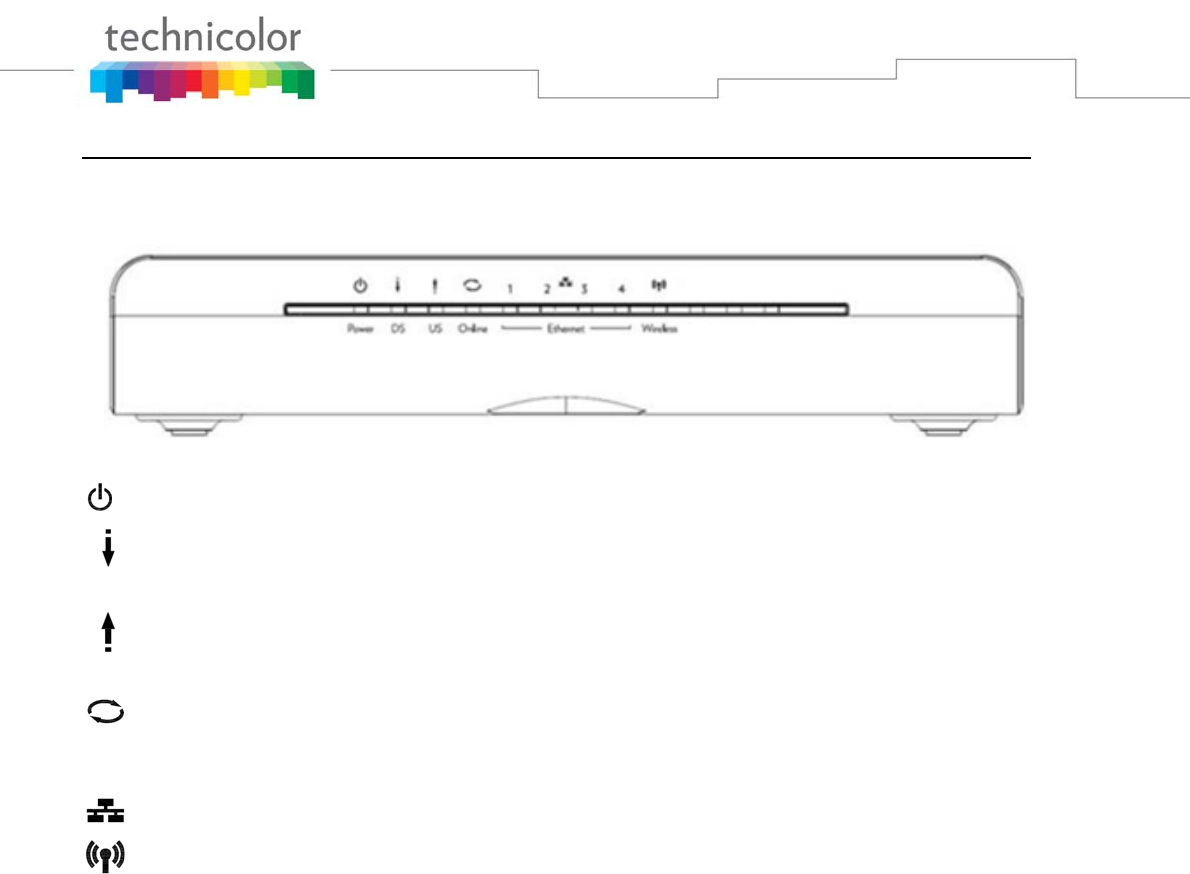
Page8/25
Wireless Gateway Overview
Front Panel
The following illustration shows the front panel:
Fig. 1-1 Front Panel
POWER - Indicates the Power status.
DS - Indicates the status of Data reception by the cable modem from the Network (Downstream
Traffic).
US - Indicates the status of Data transmission by the cable modem to the Network (Upstream
Traffic).
Online - Displays the status of your cable connection. The light is off when no cable connection is
detected and fully lit when the modem has established a connection with the network and
data can be transferred.
Ethernet - Indicates the state of Ethernet ports.
Wireless - Indicates the traffic on the wireless network.
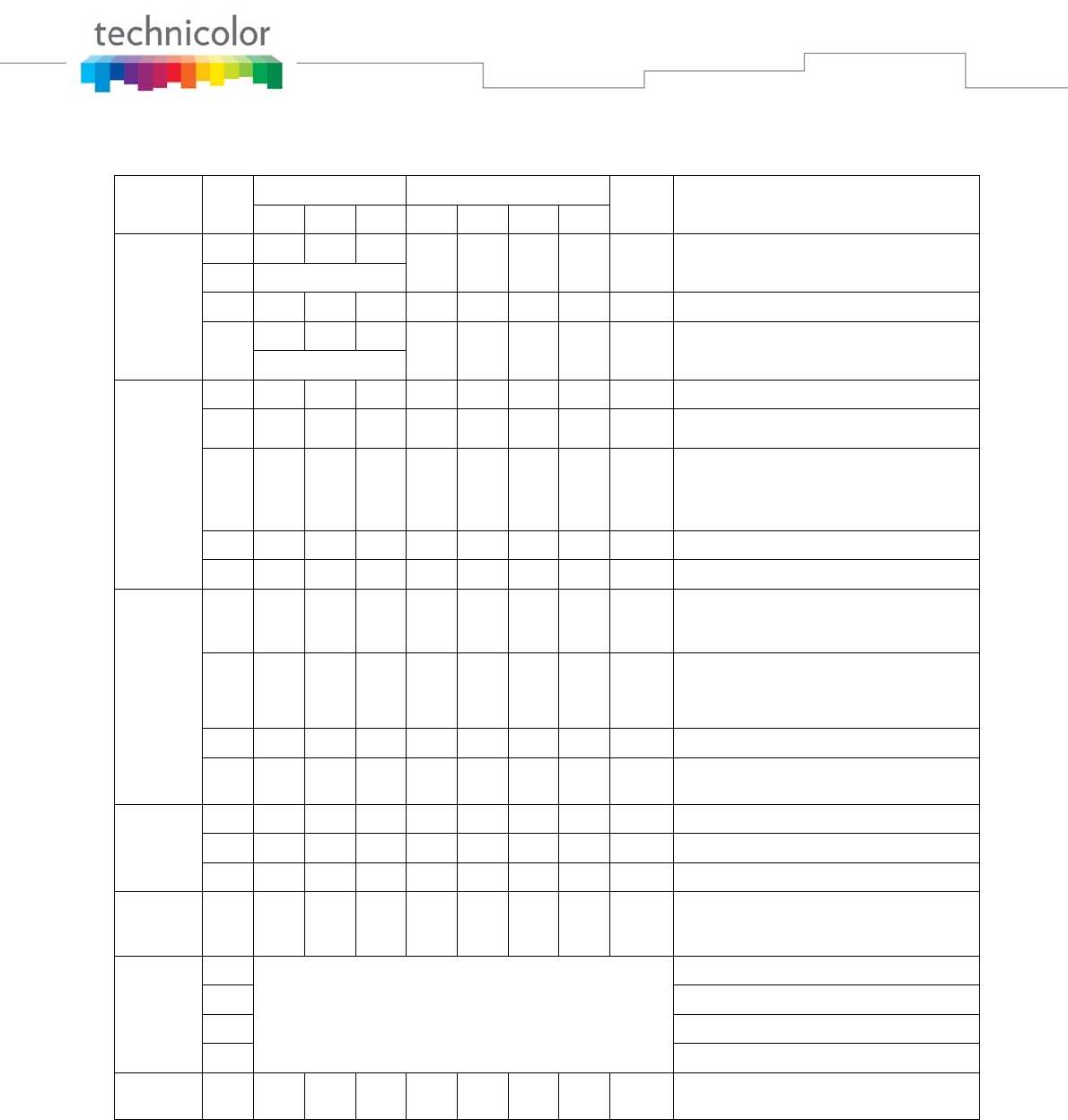
Page9/25
The lights on the front panel LEDs are described in the table below (from left to right):
ON = the LED is light, OFF = the LED is gray, FLASH = the LED is blinking.
Power
InternetEthernet
Wireless Description
DSUSOnline12 3 4
Boot‐up
Operation
ONONONON
ONONONONXPoweron0.25sec
ON0.25second
ONFLASHFLASHFLASHXX X X X FrompowerONtosysteminitializationcomplete
ON
ONONON
XXXXXFollowingsysteminitializationcompleteto(before)
DSscanning
1second
DOCSIS
Start‐up
Operation
ONFLASHOFFOFFXX X X X DuringDSscanningandacquiringSYNC
ONONFLASHOFFXXXXXFromSYNCcompleted,receivingUCDtoranging
completed
ONONONFLASHXXXXX
DuringDHCP,configurationfiledownload,
registration,andBaselinePrivacyinitialization:
DHCPstatus:1secondONand1secondOFF,
TFTPstatus:0.25secondONand0.25secondOFF
ONONONONXX X X X Operational(NACO=ON)
ONFLASHFLASHOFFXX X X X Operational(NACO=OFF)
Channel
Bonding
Operation
FLASHFLASHFLASHFLASHXXXXX
WaitregistrationwithallDSandallUS
–
Lights
FlashsequentiallyfromtherighttoleftMinimum
duration3seconds
XXXXOFFXXXX
From1to4DS,from1to4LEDsareON
From5to8DS,From1to4LEDsareflashing
Duration3seconds
OFFXXXXX X X X From1to4US,from1to4LEDsareON.
FLASHFLASHFLASHFLASHXXXXXWaitregistrationwithallDSandallUS
–
Lights
Flashsequentiallyfromthelefttoright
MTA
initialization
ONONONONXX X X X MTADHCP
ONONONONXX X X X MTASNMP/TFTP
ONONONONXX X X X RSIPfor NCS/RegisterforSIP
CPE
OperationONXXX
OFF
ON
FLASH
OFF
ON
FLASH
OFF
ON
FLASH
OFF
ON
FLASH
OFF
ON
FLASH
NoEthernet /WirelessLink
Ethernet/WirelessLink
TX/RXEthernet/WirelessTraffic
MTA
Operation
ON
<CMNormalOperation>
BothLinesOn‐Hook
ONTel1Off‐hook,Tel2On‐hook
ONTel1On‐hook,Tel2Off‐hook
ONBothLinesOff‐Hook
SWDownload
OperationONFLASHFLASHONXXXXXAsoftwaredownloadandwhileupdatingthe
FLASHmemory
Table 1-1 LED behavior
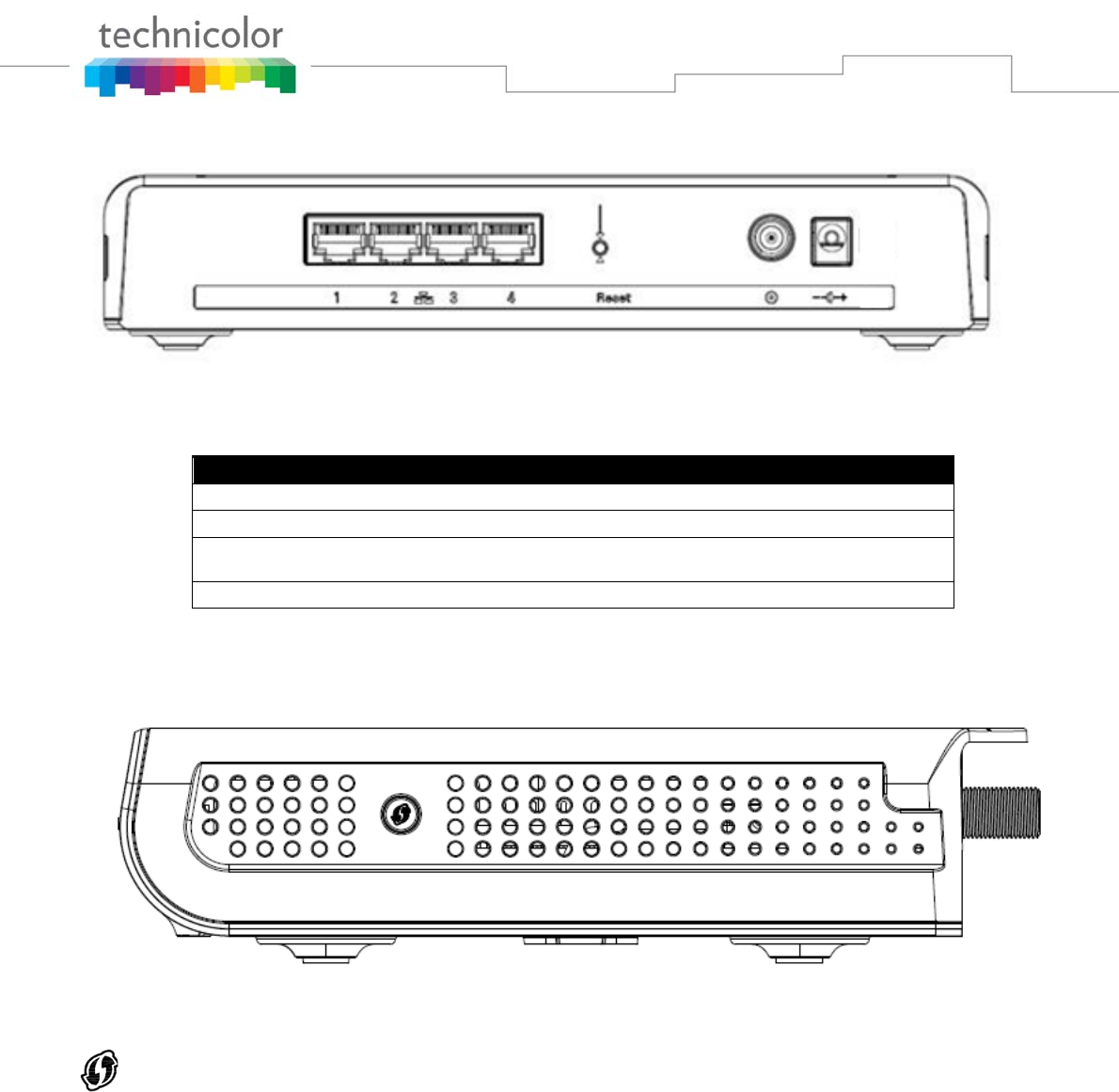
Page10/25
Rear Panel
Fig. 1-2 Rear Panel
Connector Description
Power Jack Connector for DC12V
Cable Connector for the cable network
Reset To restart the modem or press over 5 seconds can default
the modem.
Ethernet Ethernet ports, RJ-45, 10/100/1000BaseT connector
Table 1-2 Rear Panel description
Side Panel for WPS
Fig. 1-3 Side Panel
WPS - Indicates the status of the WPS (Wi-Fi Protected SetupTM) functionality.
WPS button: Wi-Fi Protected SetupTM. This button can be used to:
Secure the connection with another device (PC for example) using WPS protocol. A long press on
the button allows you to enable the association of the modem with a PC or other equipment.
After link establish. A short press on the button, switch on/off the wireless traffic.
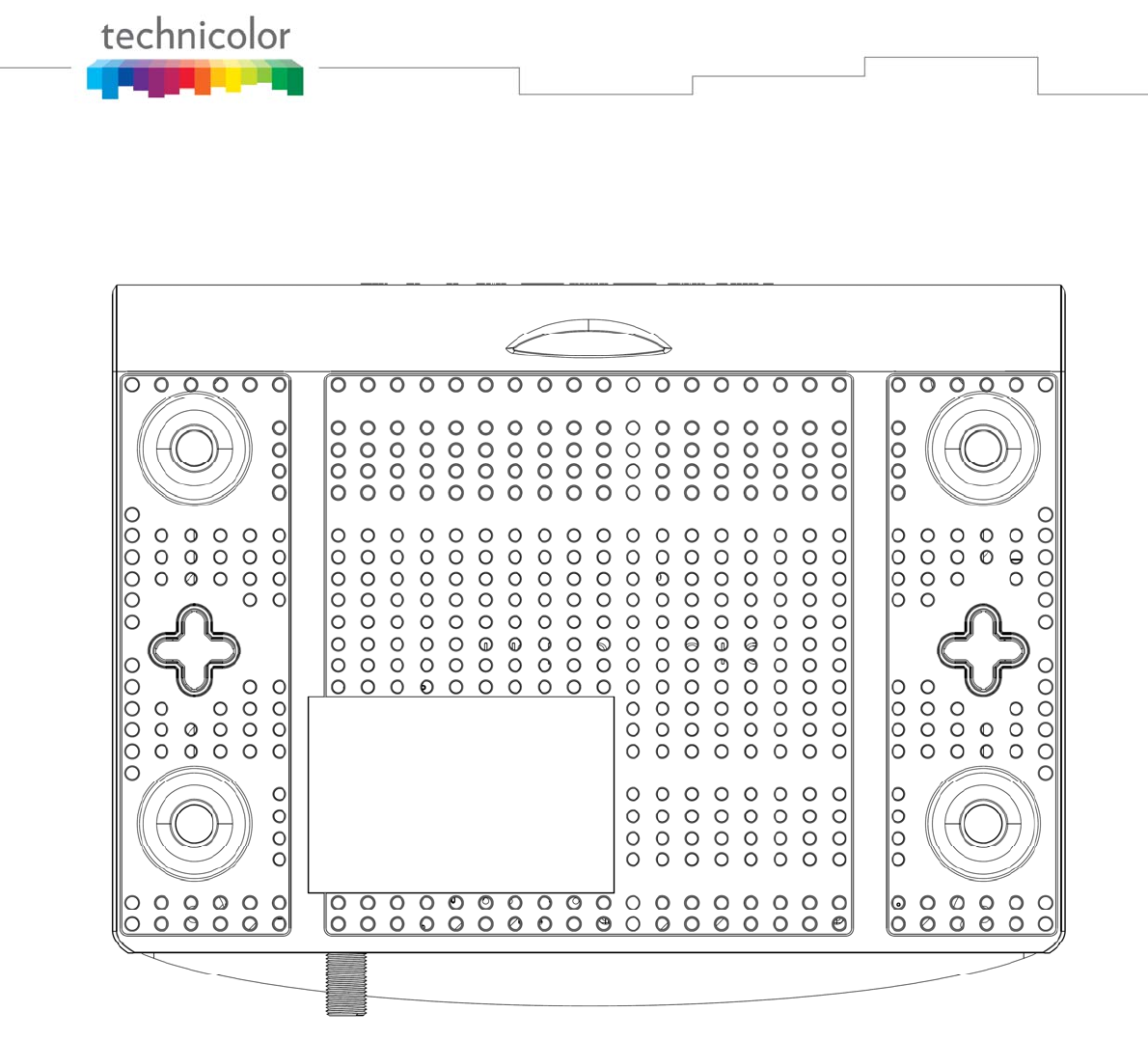
Page11/25
Wall Mounting
This article will show the user through the process of wall-mounting the Wireless Gateway
The Adapter has two wall-mount slots on its back panel.
Two screws are needed to mount the Adapter.
Fig. 1-4 Wall Mounting
To do this:
1. Ensure that the wall you use is smooth, flat, dry and sturdy and use the 2 screw holes which
are 101.6 mm (4 inches) apart from each other.
2. Fix the screws into wall, leaving their heads 3 mm (0.12 inch) clear of the wall surface.
3. Remove any connections to the unit and locate it over the screw heads. When in line, gently
push the unit on to the wall and move it downwards to secure.
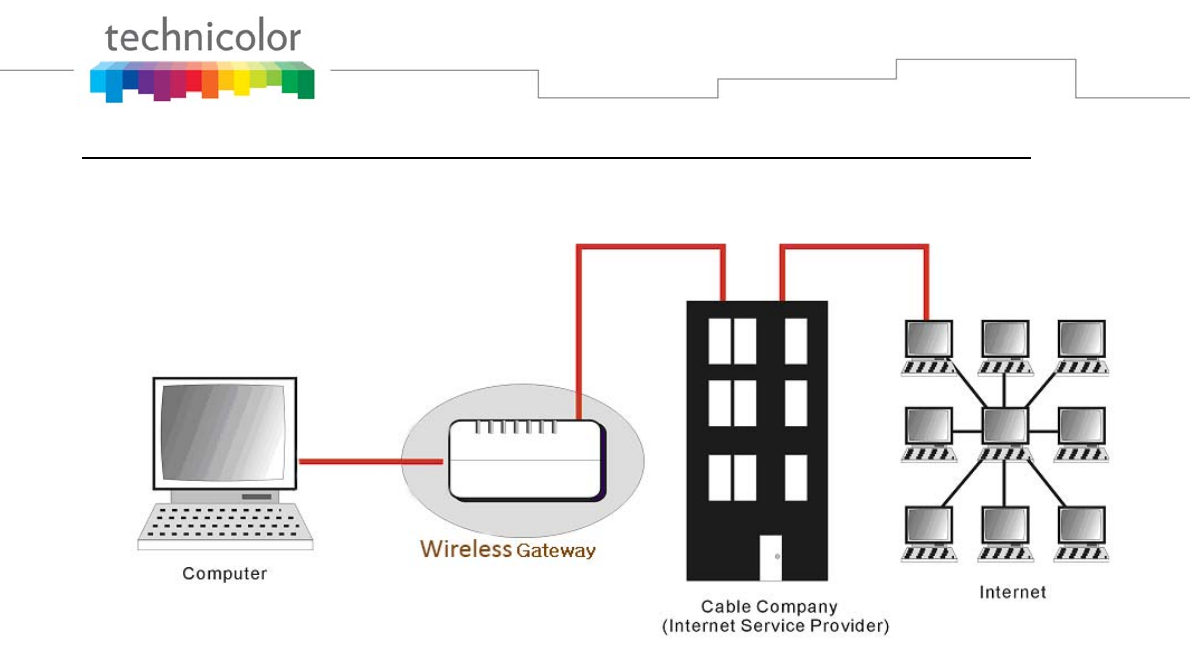
Page12/25
Relationship among the Devices
This illustration shows a cable company that offers DOCSIS compliant data services.
Fig. 1-5 Connection overview
What the Modem Does
The Wireless Gateway provides high-speed Internet access as well as cost-effective, commercial, and
education subscribers on public and private networks via an existing CATV infrastructure. The IP traffic can
transfer between the Wireless Gateway and DOCSIS compliant head-end equipment. The data security
secures upstream and downstream communications.
What the Modem Needs to Do Its Job
The Right Cable Company: Make sure your local cable company provides data services that use
cable TV industry-standard DOCSIS compliant compliant technology.
Check with your cable company to make sure you have everything you need to begin; they’ll know if you
need to install special software or re-configure your computer to make your cable internet service work for
you.
Contact Your Local Cable Company
You will need to contact your cable company to establish an Internet account before you can use your
gateway. You should have the following information ready (which you will find on the sticker on the
gateway):
• The serial number
• The model number
• The Cable Modem (CM) Media Access Control (MAC) address
• The Terminal Adapter (EMTA) MAC address
• Security information: Service Set IDentifier (SSID), Encryption key / passphrase (WPA2-PSK by
default), channel number. Default values are indicated underneath the modem on the sticker.
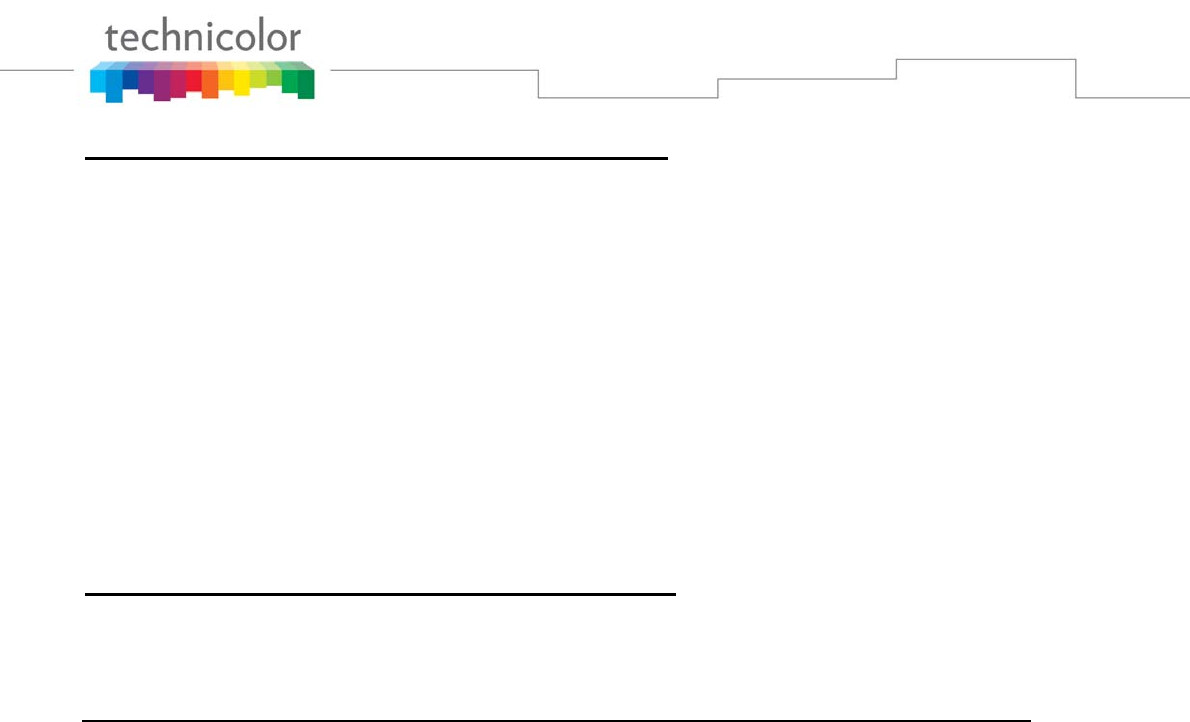
Page13/25
Please check the following with the cable company
The cable service to your home supports DOCSIS compliant two-way modem access.
Your internet account has been set up. (The Media Terminal Adapter will provide data service if the
cable account is set up but no telephony service is available.)
You have a cable outlet near your PC and it is ready for Cable Modem service.
Note: It is important to supply power to the modem at all times. Keeping your modem plugged in will keep it
connected to the Internet. This means that it will always be ready whenever you need.
Important Information
Your cable company should always be consulted before installing a new cable outlet. Do not attempt any
rewiring without contacting your cable company first.
Please verify the following on the Wireless Gateway
The Power LED should be lighted when plug-in the power supply.
Connecting the Wireless Gateway to a Single Computer
This section of the manual explains how to connect your Wireless Gateway to the Ethernet port on your
computer and install the necessary software. Please refer to Figure 1-5 to help you connect your Digital
Cable Modem for the best possible connection.
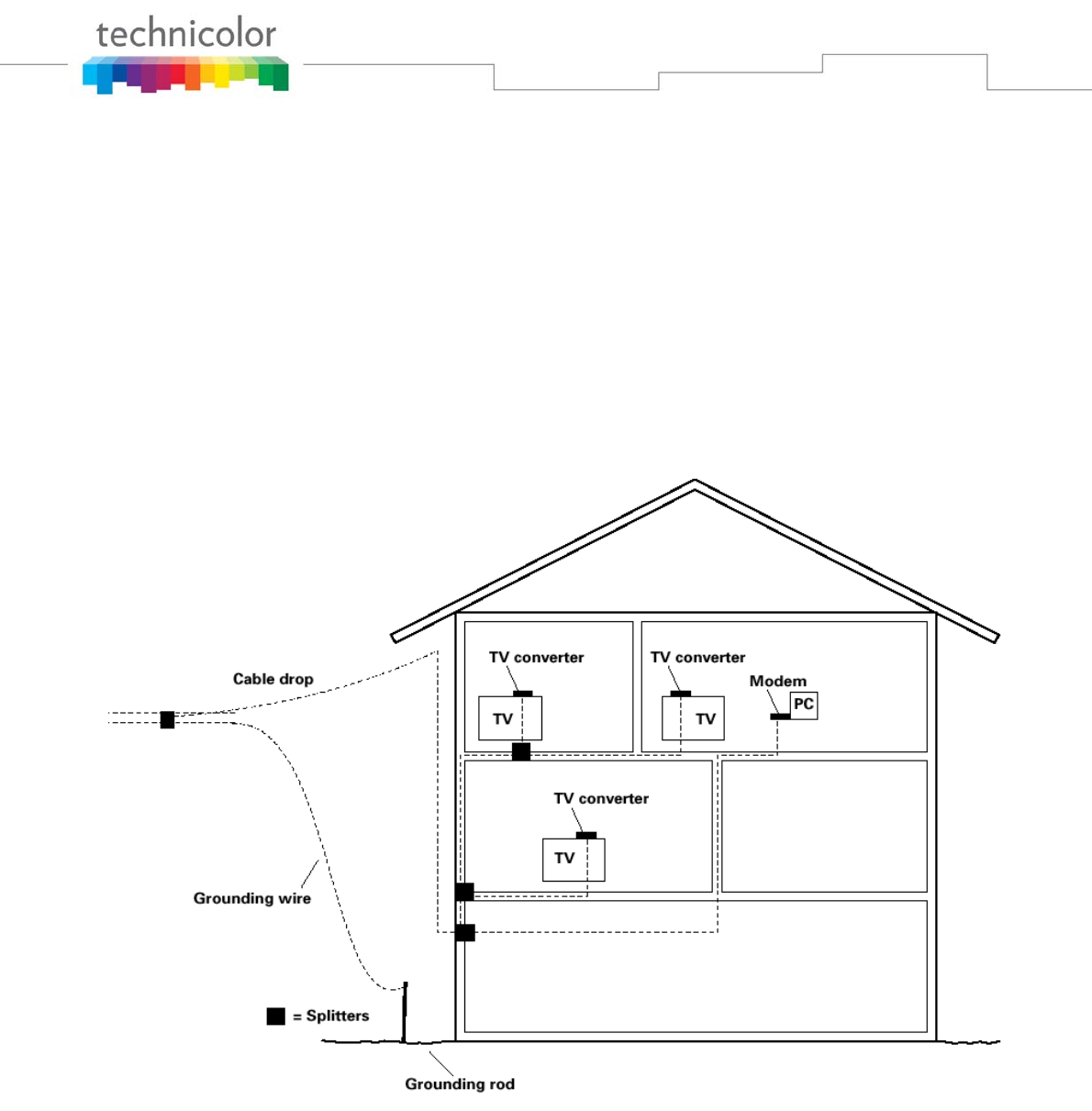
Page14/25
Attaching the Cable TV Wire to the Wireless Gateway
1. Locate the Cable TV wire. You may find it one of three ways:
a. Connected directly to a TV, a Cable TV converter box, or VCR. The line will be connected to the
jack, which should be labeled either IN, CABLE IN, CATV, CATV IN, etc.
b. Connected to a wall-mounted cable outlet.
c. Coming out from under a baseboard heater or other location. See Figure 1-5 for the wiring
example.
Notes:Foroptimumperformance,besuretoconnectyour
WirelessGatewaytothefirstpointthecableentersyourhome.
Thesplittermustberatedforatleast1GHz.
Fig. 1-6 Basic Home Wiring
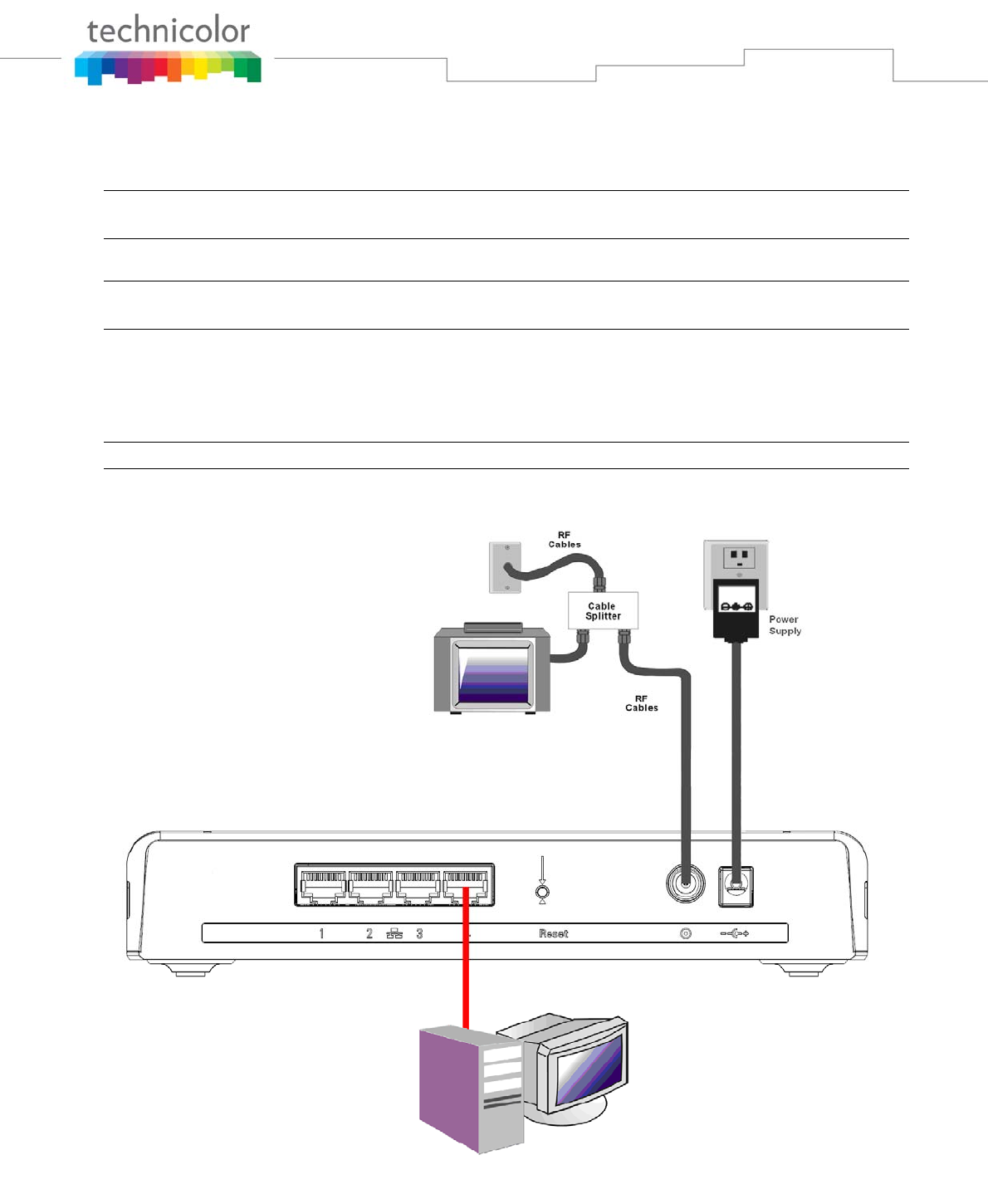
Page15/25
Installation procedure for connecting to the Ethernet interface
Follow these steps for proper installation. Plug the coaxial cable to the cable wall outlet and the other end to
the modem connector labeled "CABLE".
Note:Toensureafastregistrationofthemodem,thecoaxialcablemustbeconnectedtothemodem
beforeitispoweredon.
Plug the power supply into the socket of the cable modem and two-pin on the adatper plug into the AC outlet.
Note:Onlyusethepowersupplythatcomeswiththemodem.Usinganotherpowersupplycancause
damagetotheproduct,andwillvoidthewarranty.
Connect an Ethernet cable (direct connection, see below) to the Ethernet port at the back of the computer,
and the other end to the ETHERNET port on the rear panel of the cable modem. The modem will seek the
appropriate cable signal on the cable television network and go through the initial registration process on its
own. The modem is ready for data transfer after the green LED "ONLINE" is lit continuously.
Note:thebutton"reset"atthebackofthemodemisusedprimarilyformaintenance.
Fig. 1-7 Connect to the Modem
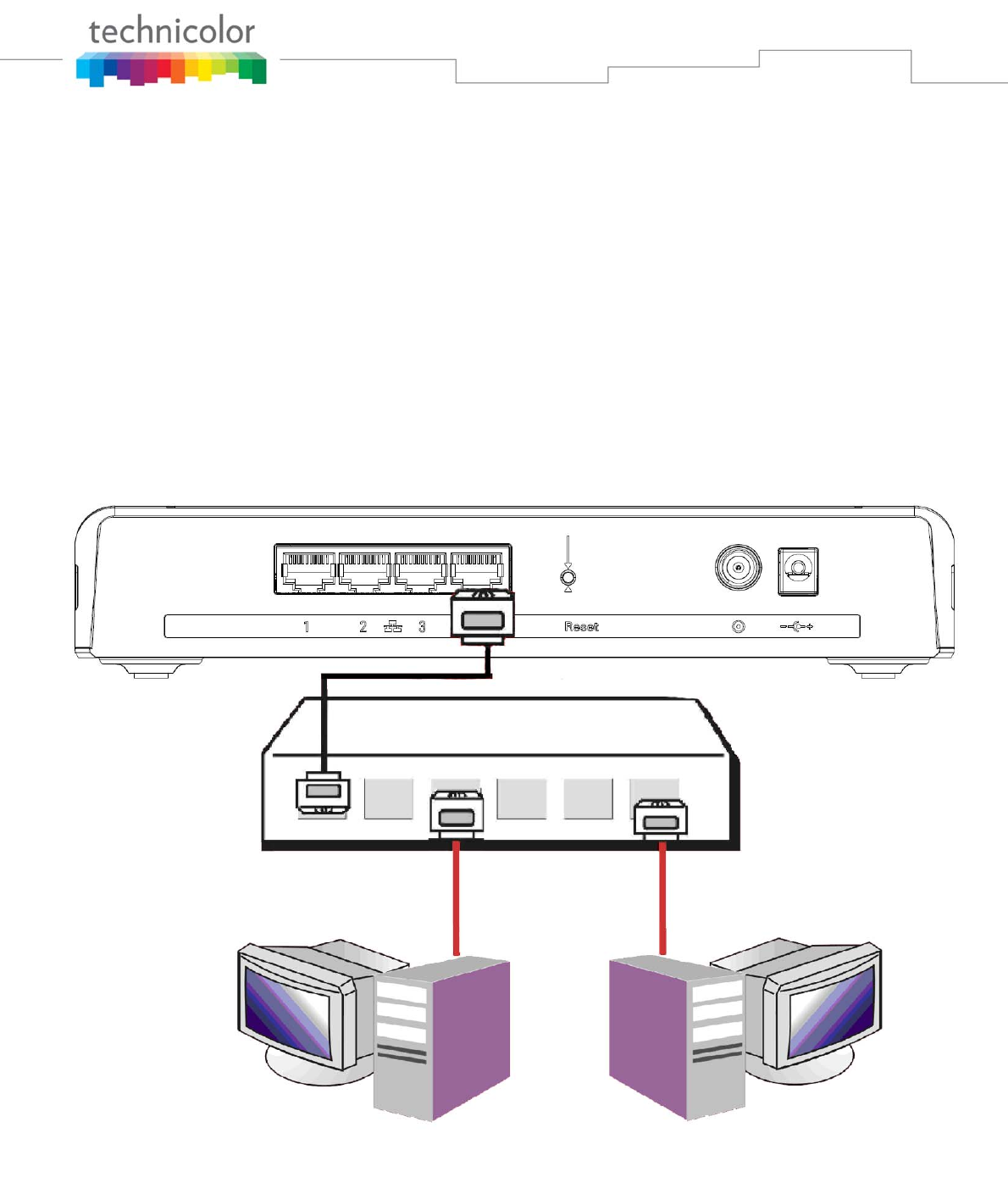
Page16/25
Connecting More Than one Computer to the Wireless Gateway
If you need to connect more than two computers or if you need to connect two computers, you’ll need the
following additional equipment (if supported by your cable operator):
• Crossover-wired, or “null,” category 5 Ethernet cable for the cable modem to be connected to the
hub
• 10/100/1000BaseT Hub or Switch
• Straight through, or standard, category 5 Ethernet cable (one for each computer to be connected)
If you have a hub with an uplink port a straight through cable can be used in combination with that port in
lieu of the crossover cable.
An uplink port has a small switch on it to change the polarity of the connection. It can accept either a
crossover or a straight cable, depending on the setting.
Fig. 1-8 Connect to two more computer
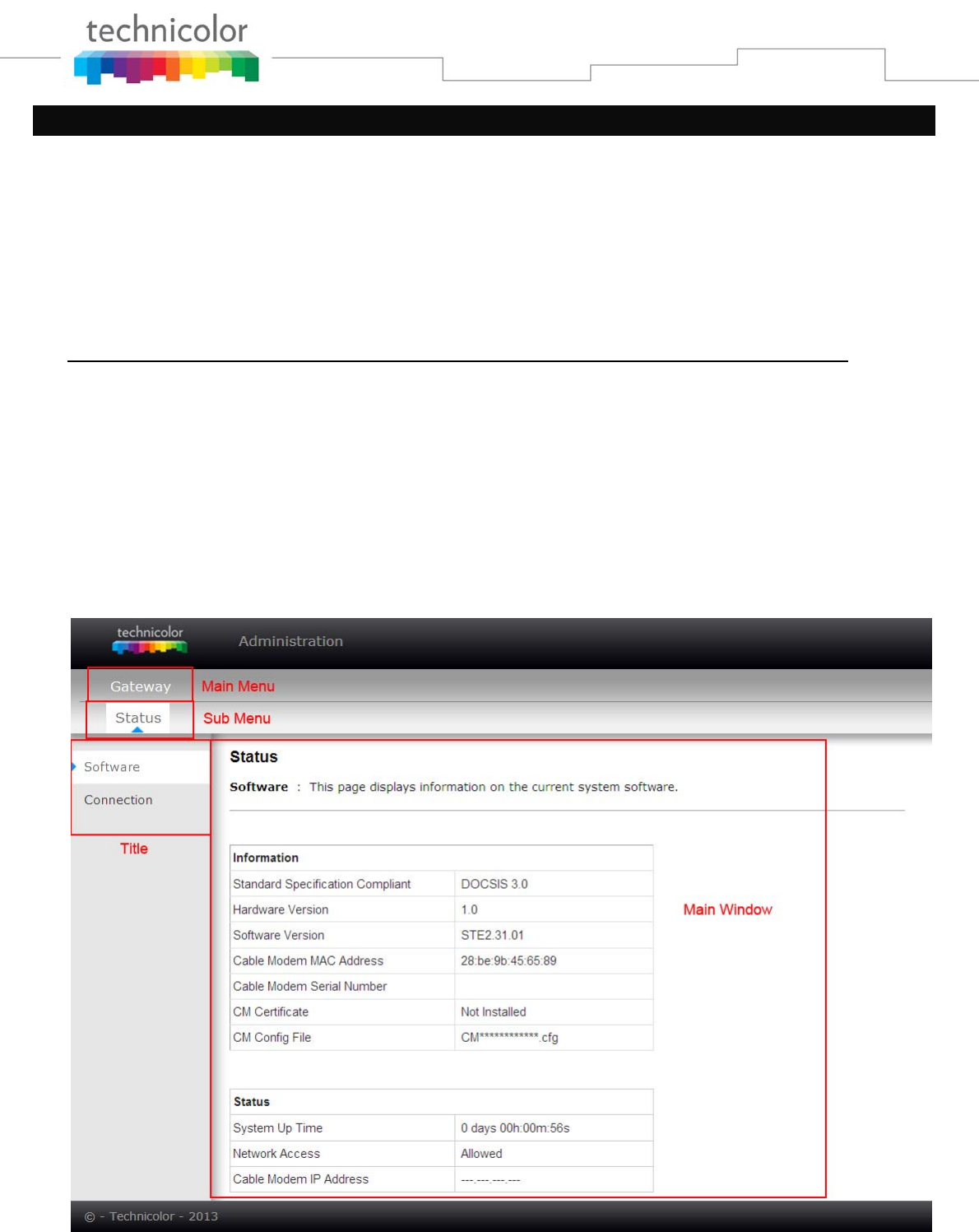
Page17/25
CHAPTER 2: WEB CONFIGURATION
To make sure that you can access the Internet successfully, please check the following first.
1. Make sure the connection (through Ethernet) between the Wireless Gateway and your computer is OK.
2. Make sure the TCP/IP protocol is set properly.
3. Subscribe to a Cable Company.
Accessing the Web Configuration
The Wireless Gateway offers local management capability through a built-in HTTP server and a number of
diagnostic and configuration web pages. You can configure the settings on the web page and apply them to
the device.
Once your host PC is properly configured; please proceed as follows:
1. Start your web browser and type the private IP address of the Wireless Gateway on the URL
field: 192.168.0.1, the main page will appear.
Outline of Web Manager
The main screen will be shown as below.
Fig. 2-1 Outline of Web Manager

Page18/25
z Main Menu: the hyperlinks on the top of the page, including Gateway and several sub-menu items
z Sub Menu: under the main menu, sub menu use to enter each function, e.g., Status
z Title: the sidebar on the left side of the page indicates the title of this management interface, e.g.,
Software in this example
z Main Window: the current workspace of the web management, containing configuration or status
information
For easy navigation, the pages are organized in groups with group in names main menu. Individual page
names within each group are provided in the sub menu and sidebar. So to navigate to a page, click the group
hyperlink at the top, then the sub menu for the function, finally choose the title on the sidebar.
Your cable company may not support the reporting of some items of information listed on your gateway’s
internal web pages. In such cases, the information field appears blank. This is normal.
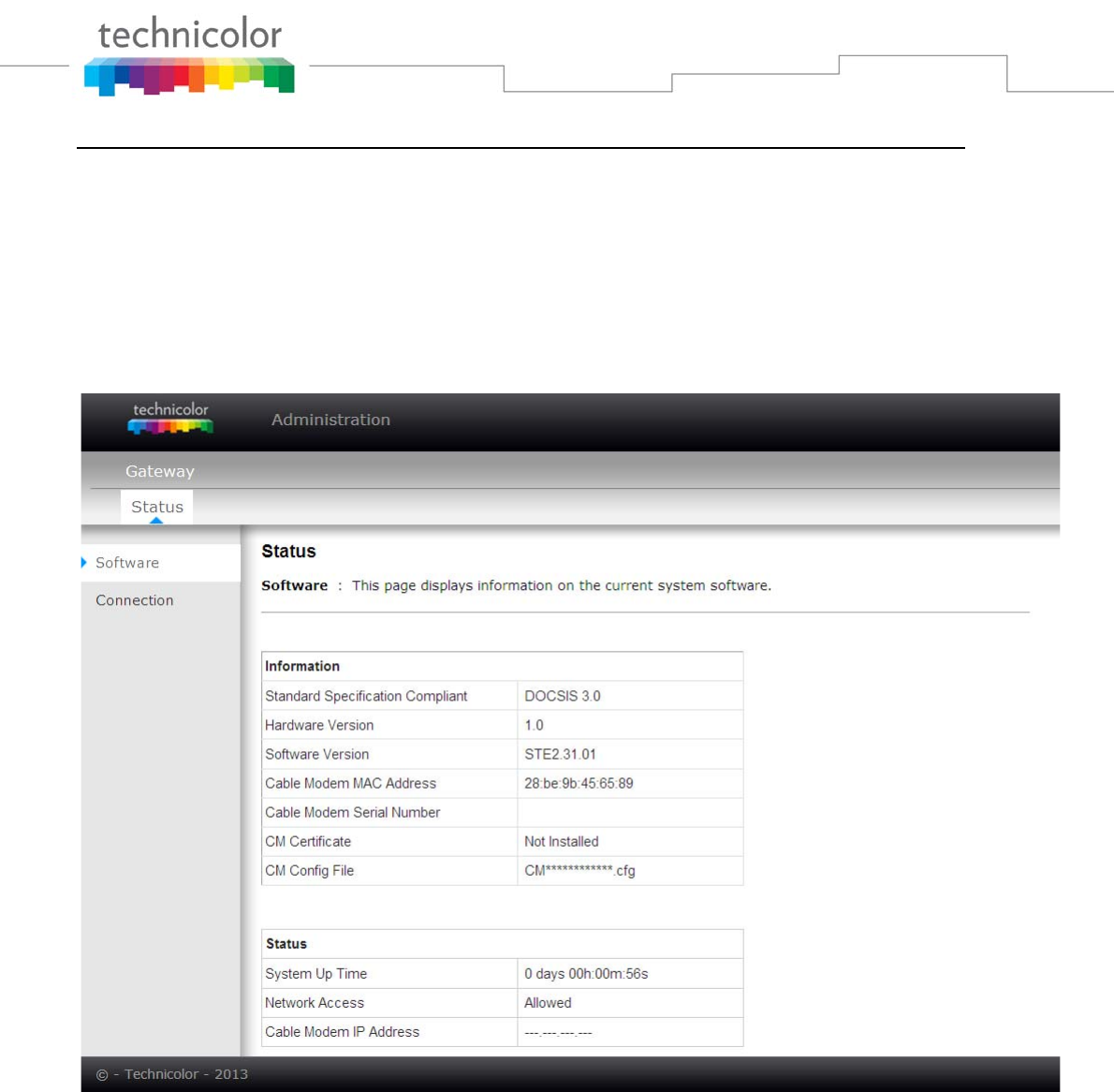
Page19/25
Gateway – Status Web Page Group
Software
The information section shows the hardware and software information about your gateway.
The status section of this page shows how long your gateway has operated since last time being powered up,
and some key information the Cable Modem received during the initialization process with your cable
company. If Network Access shows “Allowed,” then your cable company has configured your gateway to
have Internet connectivity. If not, you may not have Internet access, and should contact your cable company
to resolve this.
Fig.2-2 Gateway\Status\Software
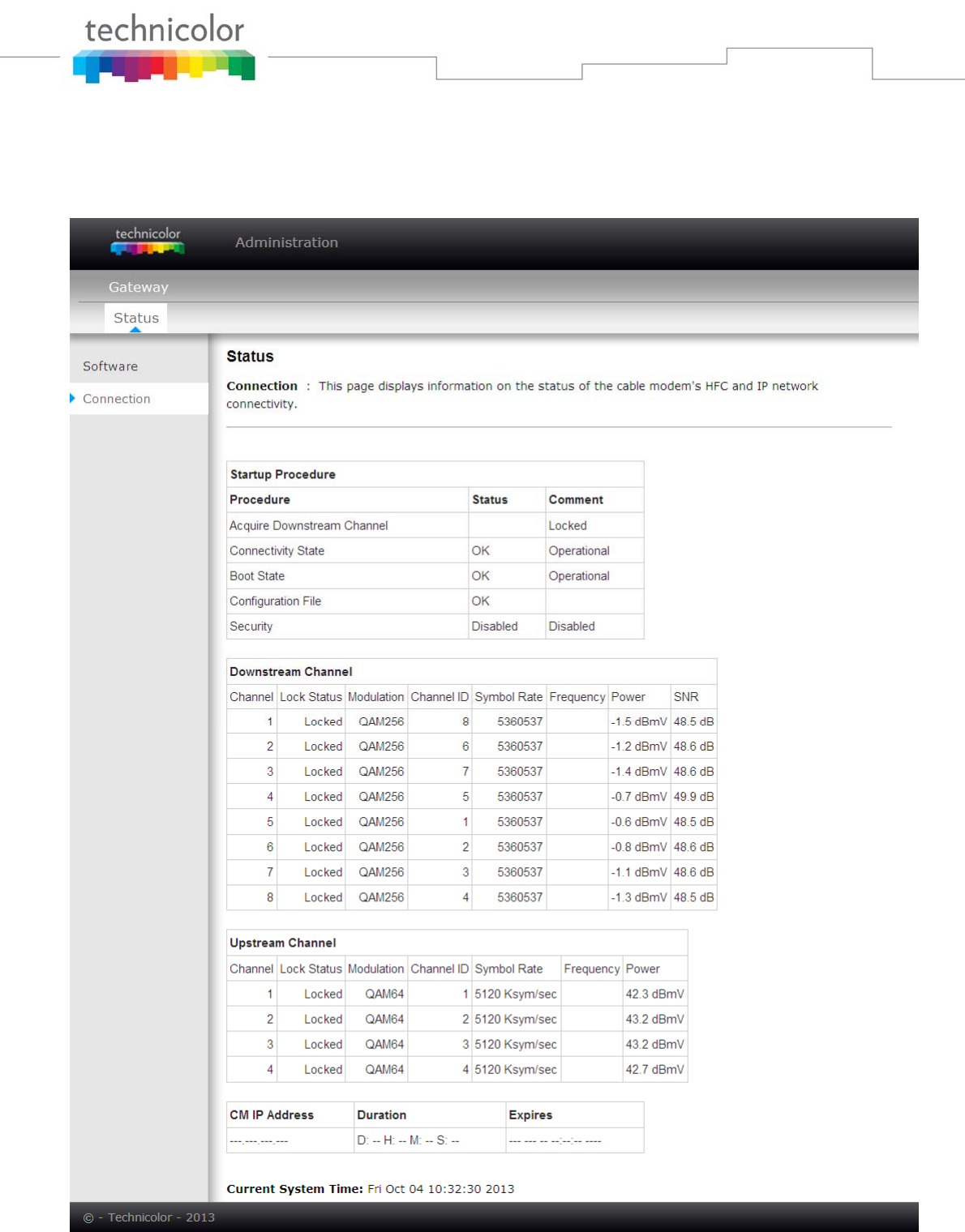
Page20/25
Connection
This page reports current connection status containing startup procedures, downstream and upstream status,
CM online information, and so on. The information can be useful to your cable company’s support
technician if you’re having problems.
Fig. 2-3 Gateway\Status\Connection

Page21/25
CHAPTER 3: ADDITIONAL INFORMATION
Frequently Asked Questions
Q. How do I get the system installed?
A. Professional installation from your cable provider is strongly recommended. They will ensure proper
cable connection to the modem and your computer. However, your retailer may have offered a self
installation kit, including the necessary software to communicate with your cable ISP.
Q. Once my Wireless Gateway is connected, how do I get access to the Internet?
A. Your local cable company provides your internet service*, offering a wide range of services including
email, chat, and news and information services, and a connection to the World Wide Web.
Q. It seems that the wireless network is not working
A. Check the Wireless LED on the front panel. If it is no lighted, press on the WPS button shortly, less than
1 second, on the side of the modem, and then check again the Wireless LED. If it is lighted, then the
Wireless transmission is enabled.
Q. Can I watch TV, surf the Internet, and talk to my friends through the Wireless Gateway at the same
time?
A. Absolutely!
Q. What do you mean by “Broadband?”
A. Simply put, it means you’ll be getting information through a “bigger pipe,” with more bandwidth, than a
standard phone line can offer. A wider, “broader” band means more information, more quickly.
Q. What is DOCSIS and what does it mean?
A. “Data over Cable Service Interface Specifications” is the industry standard that most cable companies are
adopting as they upgrade their systems. Should you ever decide to move, the Wireless Gateway will work
with all upgraded cable systems that are DOCSIS-compliant.
Q. What is Xpress Technology and what does it mean?
A. It is one of the popular performance-enhancing WiFi technologies, designed to improve wireless network
efficiency and boost throughput. It is more efficient in mixed environments, and it can work with
802.11a/b/g networks. When Xpress is turned on, aggregate throughput (the sum of the individual
throughput speeds of each client on the network) can improve by up to 27% in 802.11g-only networks,
and up to 75% in mixed networks comprised of 802.11g and 802.11b standard equipment. The
technology achieves higher throughput by re-packaging data, reducing the number of overhead control
packets, so that more useful data can be sent during a given amount of time.
* Monthly subscription fee applies.
** Additional equipment required. Contact your cable company and ISP for any restrictions or additional fees.
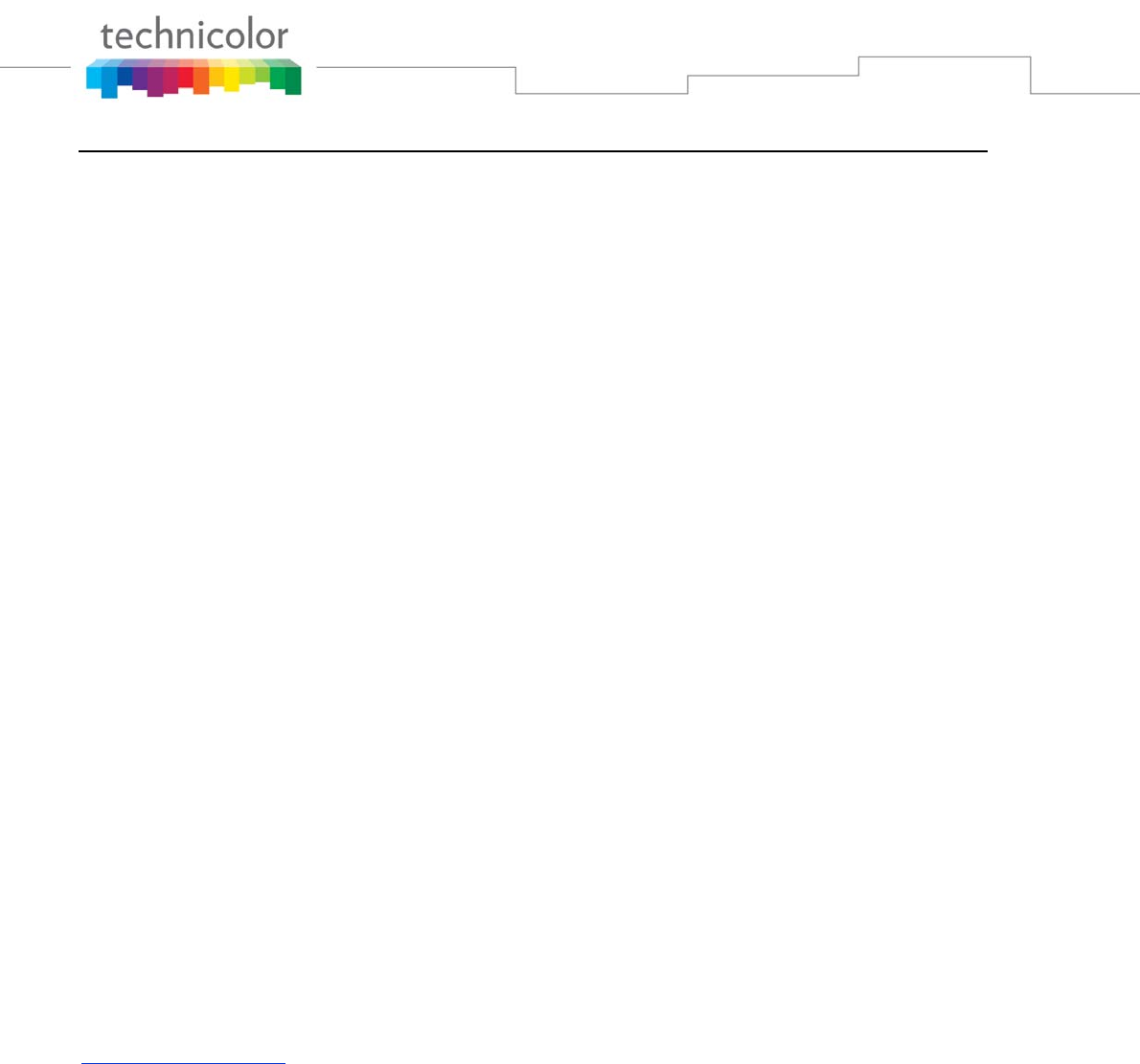
Page22/25
General Troubleshooting
You can correct most problems you have with your product by consulting the troubleshooting list that
follows.
I can’t access the internet.
z Check all of the connections to your Wireless Gateway.
z Your Ethernet card may not be working. Check each product’s documentation for more information.
z The Network Properties of your operating system may not be installed correctly or the settings may be
incorrect. Check with your ISP or cable company.
I can’t get the modem to establish an Ethernet connection.
z Even new computers don’t always have Ethernet capabilities – be sure to verify that your computer has
a properly installed Ethernet card and the driver software to support it.
z Check to see that you are using the right type of Ethernet cable.
The modem won’t register a cable connection.
z If the modem is in Initialization Mode, the INTERNET light will be flashing. Call your Cable Company
if it has not completed this 5-step process within 30 minutes, and note which step it is getting stuck on.
z The modem should work with a standard RG-6 coaxial cable, but if you’re using a cable other than the
one your Cable Company recommends, or if the terminal connections are loose, it may not work. Check
with your Cable Company to determine whether you’re using the correct cable.
z If you subscribe to video service over cable, the cable signal may not be reaching the modem. Confirm
that good quality cable television pictures are available to the coaxial connector you are using by
connecting a television to it. If your cable outlet is “dead”, call your Cable Company.
z Verify that the Cable Modem service is DOCSIS compliant by calling your cable provider.
For more Usage and Troubleshooting Tips use the web site links provided on the CD-ROM:
www.technicolor.com

Page23/25
Service Information
If you purchased or leased your Wireless Gateway directly from your cable company, then warranty service
for the Digital Cable Modem may be provided through your cable provider or its authorized representative.
For information on 1) Ordering Service, 2) Obtaining Customer Support, or 3) Additional Service
Information, please contact your cable company. If you purchased your Wireless Gateway from a retailer,
see the enclosed warranty card.

Page24/25
Glossary
10/100/1000 BaseT – Unshielded, twisted pair cable with an RJ-45 connector, used with Ethernet LAN
(Local Area Network). “10/100/1000” indicates speed (10/100/1000 BaseT), “Base” refers to baseband
technology, and “T” means twisted pair cable.
Authentication - The process of verifying the identity of an entity on a network.
DHCP (Dynamic Host Control Protocol) – A protocol which allows a server to dynamically assign IP
addresses to workstations on the fly.
Ethernet adapters – A plug-in circuit board installed in an expansion slot of a personal computer. The
Ethernet card (sometimes called a Network Interface Card , network adapter or NIC) takes parallel data from
the computer, converts it to serial data, puts it into a packet format, and sends it over the 10/100/1000 BaseT
LAN cable.
DOCSIS (Data Over Cable Service Interface Specifications) – A project with the objective of developing
a set of necessary specifications and operations support interface specifications for Cable Modems and
associated equipment.
F Connector – A type of coaxial connector, labeled CABLE IN on the rear of the Wireless Gateway that
connects the modem to the cable system.
HTTP (HyperText Transfer Protocol) – Invisible to the user, HTTP is used by servers and clients to
communicate and display information on a client browser.
Ethernet Switch – A device used to connect multiple computers to the Wireless Gateway via Ethernet.
IP Address – A unique, 32-bit address assigned to every device in a network. An IP (Internet Protocol)
address has two parts: a network address and a host address. This modem receives a new IP address from
your cable operator via DHCP each time it goes through Initialization Mode.
Key exchange - The swapping of mathematical values between entities on a network in order to allow
encrypted communication between them.
MAC Address – The permanent “identity” for a device programmed into the Media Access Control layer in
the network architecture during the modem’s manufacture.
Provisioning - The process of enabling the Media Terminal Adapter (MTA) to register and provide services
over the network.
TCP/IP (Transmission Control Protocol/Internet Protocol) – A networking protocol that provides
communication across interconnected networks, between computers with diverse hardware architectures and
various operating systems.
TFTP - Trivial File Transfer Protocol, the system by which the Media Terminal Adapter’s configuration
data file is downloaded.
Universal Serial Bus (USB) – USB is a “plug-and-play” interface between a computer and add-on devices,
such as a Wireless Gateway.
Xpress Technology - One of the popular performance-enhancing WiFi technologies, designed to improve
wireless network efficiency and boost throughput. It is more efficient in mixed environments, and it can
work with 802.11a/b/g networks.
Federal Communication Commission Interference Statement
This device complies with Part 15 of the FCC Rules. Operation is subject to
the following two conditions: (1) This device may not cause harmful
interference, and (2) this device must accept any interference received,
including interference that may cause undesired operation.
This equipment has been tested and found to comply with the limits for a
Class B digital device, pursuant to Part 15 of the FCC Rules. These limits
are designed to provide reasonable protection against harmful interference in a
residential installation. This equipment generates, uses and can radiate radio
frequency energy and, if not installed and used in accordance with the
instructions, may cause harmful interference to radio communications.
However, there is no guarantee that interference will not occur in a particular
installation. If this equipment does cause harmful interference to radio or
television reception, which can be determined by turning the equipment off
and on, the user is encouraged to try to correct the interference by one of the
following measures:
- Reorient or relocate the receiving antenna.
- Increase the separation between the equipment and receiver.
- Connect the equipment into an outlet on a circuit different from that
to which the receiver is connected.
- Consult the dealer or an experienced radio/TV technician for help.
FCC Caution: Any changes or modifications not expressly approved by the
party responsible for compliance could void the user's authority to operate this
equipment.
This transmitter must not be co-located or operating in conjunction with any
other antenna or transmitter.
Radiation Exposure Statement:
This equipment complies with FCC radiation exposure limits set forth for an
uncontrolled environment. This equipment should be installed and operated
with minimum distance 20cm between the radiator & your body.
Note: The country code selection is for non-US model only and is not
available to all US model. Per FCC regulation, all WiFi product marketed in
US must fixed to US operation channels only.